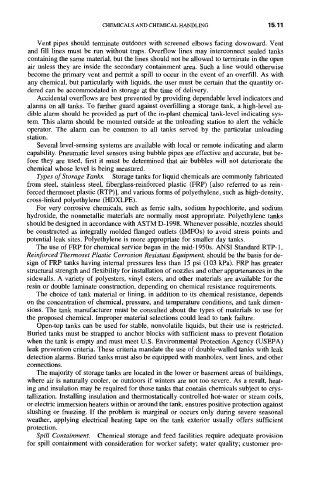Page 501 -
P. 501
CHEMICALS AND CHEMICAL HANDLING ] 5. ] 1
Vent pipes should terminate outdoors with screened elbows facing downward. Vent
and fill lines must be run without traps. Overflow lines may interconnect sealed tanks
containing the same material, but the lines should not be allowed to terminate in the open
air unless they are inside the secondary containment area. Such a line would otherwise
become the primary vent and permit a spill to occur in the event of an overfill. As with
any chemical, but particularly with liquids, the user must be certain that the quantity or-
dered can be accommodated in storage at the time of delivery.
Accidental overflows are best prevented by providing dependable level indicators and
alarms on all tanks. To further guard against overfilling a storage tank, a high-level au-
dible alarm should be provided as part of the in-plant chemical tank-level indicating sys-
tem. This alarm should be mounted outside at the unloading station to alert the vehicle
operator. The alarm can be common to all tanks served by the particular unloading
station.
Several level-sensing systems are available with local or remote indicating and alarm
capability. Pneumatic level sensors using bubble pipes are effective and accurate, but be-
fore they are used, first it must be determined that air bubbles will not deteriorate the
chemical whose level is being measured.
Types of Storage Tanks. Storage tanks for liquid chemicals are commonly fabricated
from steel, stainless steel, fiberglass-reinforced plastic (FRP) [also referred to as rein-
forced thermoset plastic (RTP)], and various forms of polyethylene, such as high-density,
cross-linked polyethylene (HDXLPE).
For very corrosive chemicals, such as ferric salts, sodium hypochlorite, and sodium
hydroxide, the nonmetallic materials are normally most appropriate. Polyethylene tanks
should be designed in accordance with ASTM D-1998. Whenever possible, nozzles should
be constructed as integrally molded flanged outlets (IMFOs) to avoid stress points and
potential leak sites. Polyethylene is more appropriate for smaller day tanks.
The use of FRP for chemical service began in the mid-1950s. ANSI Standard RTP-1,
Reinforced Thermoset Plastic Corrosion Resistant Equipment, should be the basis for de-
sign of FRP tanks having internal pressures less than 15 psi (103 kPa). FRP has greater
structural strength and flexibility for installation of nozzles and other appurtenances in the
sidewalls. A variety of polyesters, vinyl esters, and other materials are available for the
resin or double laminate construction, depending on chemical resistance requirements.
The choice of tank material or lining, in addition to its chemical resistance, depends
on the concentration of chemical, pressure, and temperature conditions, and tank dimen-
sions. The tank manufacturer must be consulted about the types of materials to use for
the proposed chemical. Improper material selections could lead to tank failure.
Open-top tanks can be used for stable, nonvolatile liquids, but their use is restricted.
Buried tanks must be strapped to anchor blocks with sufficient mass to prevent flotation
when the tank is empty and must meet U.S. Environmental Protection Agency (USEPA)
leak prevention criteria. These criteria mandate the use of double-walled tanks with leak
detection alarms. Buried tanks must also be equipped with manholes, vent lines, and other
connections.
The majority of storage tanks are located in the lower or basement areas of buildings,
where air is naturally cooler, or outdoors if winters are not too severe. As a result, heat-
ing and insulation may be required for those tanks that contain chemicals subject to crys-
tallization. Installing insulation and thermostatically controlled hot-water or steam coils,
or electric immersion heaters within or around the tank, ensures positive protection against
slushing or freezing. If the problem is marginal or occurs only during severe seasonal
weather, applying electrical heating tape on the tank exterior usually offers sufficient
protection.
Spill Containment. Chemical storage and feed facilities require adequate provision
for spill containment with consideration for worker safety; water quality; customer pro-

